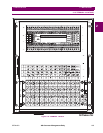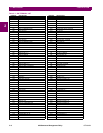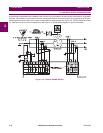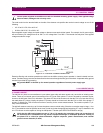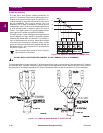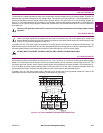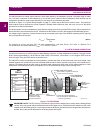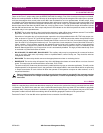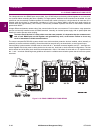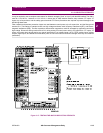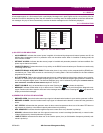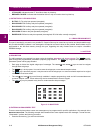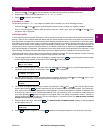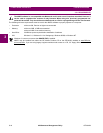
GE Multilin 489 Generator Management Relay 2-13
2 INSTALLATION 2.2 ELECTRICAL
2
2.2.10 OUTPUT RELAYS
There are six Form C output relays (see the SPECIFICATIONS for ratings). Five of the six relays are always non-failsafe,
R6 Service is always failsafe. As failsafe, R6 relay will be energized normally and de-energize when called upon to operate.
It will also de-energize when control power to the 489 is lost and therefore, be in its operated state. All other relays, being
non-failsafe, will be de-energized normally and energize when called upon to operate. Obviously, when control power is lost
to the 489, these relays must be de-energized and therefore, they will be in their non-operated state. Shorting bars in the
drawout case ensure that when the 489 is drawn out, no trip or alarm occurs. The R6 Service output will however indicate
that the 489 has been drawn out. Each output relay has an LED indicator on the 489 front panel that comes on while the
associated relay is in the operated state.
• R1 TRIP: The trip relay should be wired such that the generator is taken offline when conditions warrant. For a breaker
application, the NO R1 Trip contact should be wired in series with the Breaker trip coil.
Supervision of a breaker trip coil requires that the supervision circuit be paralleled with the R1 TRIP relay output con-
tacts, as shown in Figure 2–9: Typical Wiring Diagram on page 2–7. With this connection made, the supervision input
circuits will place an impedance across the contacts that will draw a current of 2 to 5 mA (for an external supply voltage
from 30 to 250 V DC) through the breaker trip coil. The supervision circuits respond to a loss of this trickle current as a
failure condition. Circuit breakers equipped with standard control circuits have a breaker auxiliary contact permitting
the trip coil to be energized only when the breaker is closed. When these contacts are open, as detected by the
Breaker Status digital input, trip coil supervision circuit is automatically disabled. This logic provides that the trip circuit
is monitored only when the breaker is closed.
• R2 AUXILIARY, R3 AUXILIARY, R4 AUXILIARY: The auxiliary relays may be programmed for numerous functions
such as, trip echo, alarm echo, trip backup, alarm or trip differentiation, control circuitry, etc. They should be wired as
configuration warrants.
• R5 ALARM: The alarm relay should connect to the appropriate annunciator or monitoring device.
• R6 SERVICE: The service relay will operate if any of the 489 diagnostics detect an internal failure or on loss of control
power. This output may be monitored with an annunciator, PLC or DCS.
The service relay NC contact may also be wired in parallel with the trip relay on a breaker application. This will provide
failsafe operation of the generator; that is, the generator will be tripped offline in the event that the 489 is not protecting
it. Simple annunciation of such a failure will allow the operator or the operation computer to either continue, or do a
sequenced shutdown.
Relay contacts must be considered unsafe to touch when the system is energized! If the customer requires
the relay contacts for low voltage accessible applications, it is their responsibility to ensure proper insula-
tion levels.
2.2.11 IRIG-B
IRIG-B is a standard time-code format that allows stamping of events to be synchronized among connected devices within
1 millisecond. The IRIG-B time codes are serial, width-modulated formats which are either DC level shifted or amplitude
modulated (AM). Third party equipment is available for generating the IRIG-B signal. This equipment may use a GPS satel-
lite system to obtain the time reference enabling devices at different geographic locations to be synchronized.
Terminals E12 and F12 on the 489 unit are provided for the connection of an IRIG-B signal.
WARNING



